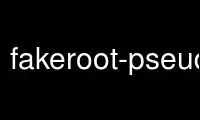
This is the command fakeroot-pseudo that can be run in the OnWorks free hosting provider using one of our multiple free online workstations such as Ubuntu Online, Fedora Online, Windows online emulator or MAC OS online emulator
PROGRAM:
NAME
fakeroot - run a command in an environment faking root privileges for file manipulation
SYNOPSIS
fakeroot [-i|-s local-state-dir] [-h|--help ] [-v|--version ] [--] [command]
DESCRIPTION
fakeroot runs a command in an environment wherein it appears to have root privileges for
file manipulation. This is useful for allowing users to create file system images,
archives and packages (tar, ar, .deb etc.) with files in them with root
permissions/ownership. Without fakeroot one would need to have root privileges to create
the constituent files of the archives with the correct permissions and ownership, and then
pack them up, or one would have to construct the archives directly, without using the
archiver. This version of fakeroot uses pseudo(1) to replace the file manipulation
library functions (chmod(2), stat(2) etc.) by ones that simulate the effect the real
library functions would have had, had the user really been root.
OPTIONS
-l arg, --lib arg
Does nothing, accepted for compatibility only.
--faked arg
Does nothing, accepted for compatibility only.
[--] command
Any command you want to be ran as fakeroot. Use ‘--’ if in the command you have
other options that may confuse fakeroot's option parsing.
-s local-state-dir
Keep the pseudo state directory on exit. This directory holds the pseudo database
files and log files. See the pseudo documentation on the details on how this
directory can be reused.
-i local-state-dir
Load a pseudo environment previously saved using -s from the specified directory.
Note that this does not implicitly save the direcotry, use -s instead for that
behaviour. Using the same file for both -i and -s in a single fakeroot invocation
is safe.
-u, --unknown-is-real Does nothing, accepted for compatibility only.
-b fd Does nothing, accepted for compatibility only.
-h Display help.
-v Display version.
EXAMPLES
Here is an example session with fakeroot. Notice that inside the fake root environment
file manipulation that requires root privileges succeeds, but is not really happening.
$ whoami
joost
$ fakeroot /bin/bash
# whoami
root
# mknod hda3 b 3 1
# ls -ld hda3
brw-r--r-- 1 root root 3, 1 Jul 2 22:58 hda3
# chown joost:root hda3
# ls -ld hda3
brw-r--r-- 1 joost root 3, 1 Jul 2 22:58 hda3
# ls -ld /
drwxr-xr-x 20 root root 1024 Jun 17 21:50 /
# chown joost:users /
# chmod a+w /
# ls -ld /
drwxrwxrwx 20 joost users 1024 Jun 17 21:50 /
# exit
$ ls -ld /
drwxr-xr-x 20 root root 1024 Jun 17 21:50 //
$ ls -ld hda3
-rw-r--r-- 1 joost users 0 Jul 2 22:58 hda3
Only the effects that user joost could do anyway happen for real.
fakeroot was specifically written to enable users to create Debian GNU/Linux packages (in
the deb(5) format) without giving them root privileges. This can be done by commands like
dpkg-buildpackage -rfakeroot or debuild -rfakeroot (actually, -rfakeroot is default in
debuild nowadays, so you don't need that argument).
SECURITY ASPECTS
fakeroot is a regular, non-setuid program. It does not enhance a user's privileges, or
decrease the system's security.
Use fakeroot-pseudo online using onworks.net services
